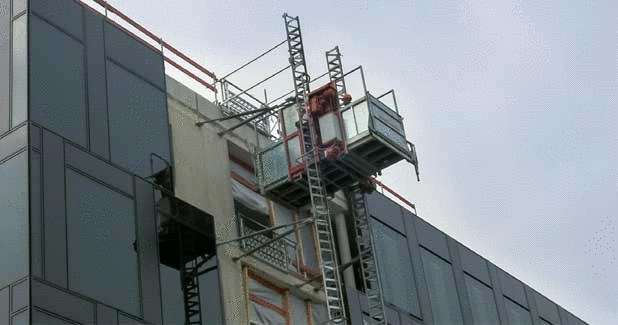
Scaling New Heights
With the high-rise construction is catching up momentum in the country, the Indian construction industry is gradually moving towards the next level of technology which has necessitated the use of new and improved construction equipment to meet the demand of safe and quality construction. Construction hoists as a medium to move material and men to heights at high rise construction sites, have seen slow growth in the past few years. However, the growth is going to catch up momentum with more structures growing taller with many high-rise building (residential and commercial) coming up.
Growing slowly
Continued growth in construction and infrastructure development has pushed the presence of global players in Indian market. Says Munish Taneja, President, Indiabulls Store One, "India is still at ground floor in terms of elevator density per 1000 people compared to other countries. Looking at the growth and developments going on, there is a huge potential for hoist market in India."
According to Samket K Dami, Director, Access Platform Equipments, In India, the demand for construction hoist is gradually increasing year on year. He adds, "In real estate, it can be estimated that every under construction high rise tower, 70 m or above is equipped with at least a construction hoist."
Demand picking up
In India, construction hoists have become very popular in the past decade. They are usually used for high-rise towers of height 70 m or more undergoing construction or renovation. Technology has improved and become affordable according to Dami as he adds, "Thanks to the availability of the technology at affordable prices compared to traditional technology of lifting manpower and material. There is a maximum requirement of hoists with a load carrying capacity of 1.4 tonne to 2 tonne and cage sizes which are 3.2 m in length and 1.5 m wide."
Taneja elaborates on the demand trend, "Growth in new and retrofit infrastructure after the recession has boosted the construction industry heavily. With new development plans and projects, use of construction equipment is also growing. Mining industry has led the hoist market with a substantial growth rate and is expected to drive the hoist market growth during the projected years. Mining hoists are responsible for conveying, manoeuvring and transporting ore materials through mine shaft and among machinery parts."
Technology to lead growth
Mechanisation helps in the construction of high-rise projects within the planned time frame. Tougher norms for quality and safety in high-rise construction have pushed the contractors and developers towards proper advanced mechanisation for building quality structures within the set time line. Dami says,"Safety, affordability and utility are the three major technology trends improving the market's demand for the construction hoists." Internet and connected features have added to the new technology advancements in the market. Taneja observes, "An increase in connectivity is the future of hoists. Internet connected smart elevators work by alerting companies on faults when they appear or about to develop. This technology works by sending the data to cloud and analysed, if operational anomalies are detected then a comparison is made to determine that a component is about to fail. All these take place in a matter of seconds and service engineer receives a message on their smart devices in real time indicating which component needs replacement. Accordingly, preventive maintenance could be done thereby reducing downtime."
Safety firss
For any equipment working at heights, safety is of paramount importance. Safety should become an inbuilt system. According to Dami, safety at height is a mandate and no longer a luxury for manpower at site. Taneja says, "Safety is paramount in construction equipment and their users. Following the international trend of according utmost importance to safety consciousness, Indian companies have also signed the UN mandate of zero reportable fatal accident and publish their safety statistics in their balance sheets."
Dami elaborates on the safety features associated with his product range, "There are multiple layers of safety features installed on a construction hoist. Some of the most basic safety features on our Scanclimber products are emergency manual lowering in case of power cut, cage overload warning in case of excess people in the elevator, exclusive speed-sensing safety brake which engages in case of rack and pinion motor failure and infrared sensors to avoid collision with unforeseen objects or projections."
For economical low rise towers/projects, APEL has been offering transport platforms from Scanclimber. "The demand for the product is slow but we believe it to take pace in the next couple of years," says Dami. He adds, To increase productivity but retain affordability for customers with project completion deadlines, we have been offering the twin-cage configurations, which cater to a larger team of manpower on the same installation of the single cage construction hoist."
Market outlook
With more high-rise structures and special structures on the rise, the market for construction hoists is expected to pick up. However, an unstable outlook of real estate sector is a concern for the pick up of construction hoists market. "Real estate sector is the most important stake holder controlling the demand of construction hoists. Proportionally, the market for construction hoist is slow," Dami observes. Taneja adds, "Construction hoist market is to witness steady expansion from 2019 to 2024." Going forward, construction hoists will have a greater role to play in terms of safe and productive movement of men and materials to newer heights. However, this will be only powered with the help of proper safety regulations and the user market following these norms regularly.
- Sudheer Vathiyath


 +91-22-24193000
+91-22-24193000 Subscriber@ASAPPinfoGlobal.com
Subscriber@ASAPPinfoGlobal.com